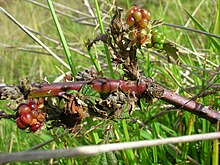Rubus armeniacus
| Rubus armeniacus Himalayan blackberry | |
|---|---|

| |
| Shoot with immature fruit | |

| |
| Scientific classification | |
| Kingdom: | |
| (unranked): | |
| (unranked): | |
| (unranked): | |
| Order: | |
| Family: | |
| Genus: | |
| Subgenus: | |
| Species: | R. armeniacus
|
| Binomial name | |
| Rubus armeniacus Focke 1874
| |

Rubus armeniacus, the Himalayan blackberry[1] or Armenian blackberry, is a species of Rubus in the blackberry group Rubus subgenus Rubus series Discolores (P.J. Müll.) Focke. It is native to Armenia and Northern Iran, and widely naturalised elsewhere. Both its scientific name and origin have been the subject of much confusion, with much of the literature referring to it as either Rubus procerus or Rubus discolor, and often mistakenly citing its origin as western European.[2][3][4] Flora of North America, published in 2014, considers the taxonomy unsettled, and tentatively uses the older name Rubus bifrons.[5]
In some areas, the plant is cultivated for its berries, but in many areas it is considered a noxious weed and an invasive species.
Description
Rubus armeniacus is a perennial plant which bears biennial stems ("canes") from the perennial root system. In its first year a new stem grows vigorously to its full length of 4–10 m, trailing along the ground or arching up to 4 m high. The stem is stout, up to 2–3 cm diameter at the base, and green or reddish-tinged above if it is exposed to bright sunlight. The leaves on first year shoots are 7–20 cm long, palmately compound with five leaflets. Flowers are not produced on first year shoots. In its second year, the stem does not grow longer, but produces several side shoots, which bear smaller leaves with three leaflets (rarely a single leaflet). These leaflets are oval-acute, dark green above and pale to whitish below, with a toothed margin, and thorns along the midrib on the underside. The flowers are produced in late spring and early summer on panicles of 3–20 together on the tips of the second-year side shoots, each flower 2–2.5 cm diameter with five white or pale pink petals.
The fruit in botanical terminology is not a berry, but an aggregate fruit of numerous drupelets, 1.2–2 cm diameter, ripening black or dark purple. Both first and second year shoots are spiny, with short, stout, curved, sharp spines. Mature plants form a tangle of dense arching stems, the branches rooting from the node tip when they reach the ground.[6]
Cultivation
Berry crop
The species was introduced to Europe in 1835 and to Australasia and North America in 1885. It was valued for its fruit, similar to that of common blackberries (Rubus fruticosus and allies) but larger and sweeter, making it a more attractive species for both domestic and commercial fruit production. The cultivars "Himalayan Giant" and "Theodore Reimers" are particularly commonly planted.[2][3]
Invasive species
Rubus armeniacus soon escaped from cultivation and has become an invasive species in most of the temperate world.[2][7][8][9] Because it is so hard to contain, it quickly got out of control, with birds and other animals eating the fruit and then spreading the seeds.[10]
References
- ^ NRCS. "Rubus armeniacus". PLANTS Database. United States Department of Agriculture (USDA). Retrieved 24 October 2015.
- ^ a b c Ceska, A. (1999). Rubus armeniacus - a correct name for Himalayan Blackberries Botanical Electronic News 230. Available online.
- ^ a b Flora of NW Europe: Rubus armeniacus
- ^ University of British Columbia Botany Photo of the Day: July 21, 2005 : Rubus armeniacus
- ^ Lawrence A. Alice; Douglas H. Goldman; James A. Macklin; Gerry Moore (2014), "Rubus bifrons Vest, Steyermärk. Z. 3: 163. 1821", Flora of North America online, vol. 9
{{citation}}: Unknown parameter|last-author-amp=ignored (|name-list-style=suggested) (help) - ^ Francis, J. K. (2003). Rubus discolor Weihe & Nees. pdf file
- ^ [citation needed]
- ^ USDA Plant Profile: Rubus armeniacus
- ^ Max Bennett; Extension forester; Jackson County (February 2007). "Managing Himalayan Blackberry in western Oregon riparian areas" (PDF). Oregon State University. Retrieved 2014-05-26.
It escaped cultivation and has since invaded a variety of sites, including low-elevation streamside areas throughout the Pacific Northwest. Listed as a noxious weed in Oregon, Himalayan blackberry rapidly occupies disturbed areas, is very difficult to eradicate once established, and tends to out-compete native vegetation. For those trying to restore or enhance native streamside vegetation, Himalayan blackberry control is a major problem.
- ^ The Nature Conservancy, Controlling Himalayan Blackberry in the Pacific Northwest by Jonathan Soll
